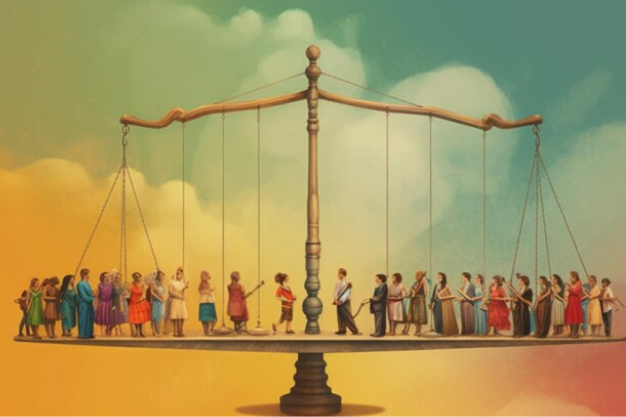
MINORITY STATUS OF AMU: CONSTITUTIONAL APPROACH IN THIS REGARD
The BJP-led NDA government declined to acknowledge the 1981 amendment to the AMU Act and advocated adherence to the precedent set by the five-judge constitution bench ruling in the S Azeez Basha versus Union of India case in 1967. In the aforementioned ruling, the constitution bench determined that as the AMU is a central university, it does not qualify as a minority institution.
In the case of Aligarh Muslim University v. Naresh Agarwal, Civil Appeal No. 2286/2006, the Seven-Judge Constitution Bench, comprised of Dr. DY Chandrachud, CJ., Sanjiv Khanna, Surya Kant, JB Pardiwala, Dipankar Datta, Manoj Misra, and Satish Chandra Sharma, JJ., commenced the deliberation of legal matters pertinent to the issue at hand. The appeal challenges the Allahabad High Court’s ruling in Naresh Agarwal (Dr.) v. Union of India, 2005 SCC, wherein the AMU's reservation of 50 percent of postgraduate medical course seats for Muslim candidates, under the claim of being a minority institution, was invalidated. The High Court held that AMU cannot enforce exclusive reservation as it does not qualify as a minority institution.
The legal context surrounding the ongoing dispute originates from the rulings in the cases of S. Azeez Basha v. Union of India (1968) and Naresh Agarwal (Dr.) v. Union of India (2005) by the Allahabad High Court. These cases collectively prompt the Supreme Court, through its constitutional bench, to ascertain the official status of Aligarh Muslim University (AMU).
The legal questions raised under this case:
- What are the indicia for treating an educational institution as a minority educational institution?
- Would an institution be regarded as a minority educational institution because it was established by a person or persons belonging to a religious or linguistic minority or it is being administered by a person or persons belonging to a religious or linguistic minority?”
A similar question was heard by the Court in T.M.A. Pai Foundation v. State of Karnataka, (2002) 8 SCC 481, yet it remained unanswered. Therefore, the Bench noted that the validity of the decision taken in S. Azeez Basha (supra), which had been challenged remained unsettled.
Constitutional provision in this regard-
Article 30(1) in Part III of the Constitution empowers all religious and linguistic minorities with a fundamental right to establish and administer educational institutions of their choice. Clause 2 ensures that the State maintains ‘equality of treatment’ in granting aid to all educational institutions, irrespective of their minority status. This includes educational institutions at all levels, from primary schools to professional education.
Legislations made in this regard.
The Aligarh Muslim University (Amendment) Act, 1965, whereby, the University Court no longer remained the supreme governing body and could no longer exercise the powers conferred on it by Section 23(2) and (3) of the Aligarh Muslim University Act, 1920 (‘1920 Act’) was brought into challenge.
The 1920 Act is not a minority institution so as to be covered under Article 30 of the Constitution of India.
Aligarh Muslim University Amendment Act, 1981-
To nullify the effect of Azeez Basha (supra), the Aligarh Muslim University Amendment Act, 1981 was brought into effect. The 1981 Act substituted the Sections of the 1920 Act which formed the basis for the verdict in Azeez Basha (supra) and the definition of the term ‘University’ was amended to mean an “educational institution of their choice established by the Muslims of India, which originated as the Muhammadan Anglo-Oriental College, Aligarh and which was subsequently incorporated as the Aligarh Muslim University”
A seven-judge constitution bench headed by Chief Justice D.Y. Chandrachud reserved its verdict on the vexed question that has repeatedly tested Parliament's legislative acumen and judiciary's prowess in interpreting complex laws involving the institution that was founded in 1875 as Muhammadan Anglo-Oriental College by prominent Muslim community members led by Sir Syed Ahmed Khan.
The observation of Justice Chandrachud said while proceeding to close the arguments in thiscase is important to be noted as he refereed:
"I can understand if the 1981 amendment had said... okay, we are going back to the original 1920 statute, confer complete minority character on this (institution)," said the CJI, who headed the bench which also included justices Sanjiv Khanna, Surya Kant, J B Pardiwala, Dipankar Datta, Manoj Misra and Satish Chandra Sharma.
Their arguments centred on the constitutional status of Aligarh Muslim University and the 1981 Amendment to the Aligarh Muslim University Act, 1920. Kaul was referring to the fact that the AMU was established by the British government, and not by the Muslim community—as recognised in Azeez Basha. The 1920 Act originally stated that the AMU Act was to “establish a teaching and residential Muslim University at Aligarh.” The 1981 amendment deleted the word “establish.” It also amended the definition of “University” to include an educational institution “established by the Muslims of India.”
Conclusion-
The issue of minority status of AMU has been a long story of controversy. The Constitution of India protects the interest of Minority community to establish educational institution as per Article 29 and 30 of constitution of India. Article 30(1) in Part III of the Constitution empowers all religious and linguistic minorities with a fundamental right to establish and administer educational institutions of their choice. Clause 2 ensures that the State maintains ‘equality of treatment’ in granting aid to all educational institutions, irrespective of their minority status. This includes educational institutions at all levels, from primary schools to professional education. Now it would be important to see the resolution of legal battle as to the status of AMU whether it would be protected as minority or not.
